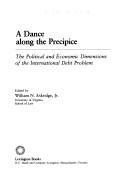| Listing 1 - 10 of 16 | << page >> |
Sort by
|
Book
ISBN: 9781107128019 1107128013 9781316422809 9781107567320 1107567327 1316566617 1316566277 1316566951 131656729X 1316568652 1316422801 1316564231 9781316568651 Year: 2016 Publisher: Oxford: Cambridge university press,
Abstract | Keywords | Export | Availability | Bookmark
 Loading...
Loading...Choose an application
- Reference Manager
- EndNote
- RefWorks (Direct export to RefWorks)
Description Contents Resources Courses About the AuthorsAccording to the doctrine of odious debt, loans which are knowingly provided to subjugate or defraud the population of a debtor state are not legally binding against that state under international law. Breaking with widespread scepticism, this groundbreaking book reaffirms the original doctrine through a meticulous and definitive examination of state practice and legal history. It restates the doctrine by introducing a new classification of odious debts and defines 'odiousness' by reference to the current, much more determinate and litigated framework of existing public international law. Acknowledging that much of sovereign debt is now governed by the private law of New York and England, Jeff King explores how 'odious debts' in international law should also be regarded as contrary to public policy in private law. This book is essential reading for practising lawyers, scholars, and development and human rights workers.
Debts, External --- Debts, Public --- Debt relief. --- International law. --- Law of nations --- Nations, Law of --- Public international law --- Law --- Debt relief --- Debt renegotiation --- Debt rescheduling --- Debt restructuring --- Relief, Debt --- Renegotiation, Debt --- Rescheduling, Debt --- Restructuring, Debt --- Debtor and creditor --- Law and legislation. --- Law and legislation --- International law --- Odious debt.

ISBN: 1854182277 9786610233212 1423721276 1280233214 1854184245 9781854182272 9781854184245 9781423721277 Year: 2003 Publisher: London : Thorogood,
Abstract | Keywords | Export | Availability | Bookmark
 Loading...
Loading...Choose an application
- Reference Manager
- EndNote
- RefWorks (Direct export to RefWorks)
This work guides the reader through every stage of debt recovery, from deciding to take action to serving a claim and the trial itself. It deals comprehensively with enforcing judgement and features sections on bankruptcy, winding up receivership and administration.
Collecting of accounts - Great Britain. --- Debtor and creditor. --- Law - Non-U.S. --- Law, Politics & Government --- Law - Great Britain --- Debt relief. --- Debt relief --- Debt renegotiation --- Debt rescheduling --- Debt restructuring --- Relief, Debt --- Renegotiation, Debt --- Rescheduling, Debt --- Restructuring, Debt --- Creditor --- Debtor and creditor --- Law and legislation --- Commercial law --- Contracts --- Obligations (Law) --- Credit --- Creditors' bills --- Fraudulent conveyances --- Liens --- Payment --- Security (Law)

ISBN: 9789004162471 900416247X 9789047431428 9047431421 1281936855 9781281936851 9786611936853 6611936858 Year: 2007 Publisher: Leiden ; Boston : Martinus Nijhoff Publishers,
Abstract | Keywords | Export | Availability | Bookmark
 Loading...
Loading...Choose an application
- Reference Manager
- EndNote
- RefWorks (Direct export to RefWorks)
The insolvency of sovereign debtors is a virtually timeless phenomenon and yet the existing international financial architecture does not provide any legal framework to deal with this issue. Following an overview of the main proposals as to how to bridge this gap, this study analyses the extent to which public international law can be used as a source for the establishment of a reorganisation system for sovereign debt. While there is no adequate customary international law relating to sovereign insolvencies, reference can instead be made to the growing body of general principles of law. This is illustrated by a comparison of the systems of corporate financial reorganisation in insolvency in six representatively selected countries - Argentina, England, France, Germany, Indonesia and the U.S. Due to the inherent lack of enforceability with regard to sovereign debtors, in order to be able to provide a basis for a reorganisation system for sovereign debt, these principles need to be complemented with a compliance control mechanism. This study suggests how such a system could be constructed and implemented.
Debts, Public --- Debt relief. --- State bankruptcy. --- Finance, Public --- Dettes publiques --- Dettes --- Faillite d'Etat --- Finances publiques --- Law and legislation. --- Law and legislation --- Droit --- Allègement --- Debt relief --- State bankruptcy --- Bankruptcy, National --- National bankruptcy --- Bankruptcy --- International law --- Repudiation --- Debt renegotiation --- Debt rescheduling --- Debt restructuring --- Relief, Debt --- Renegotiation, Debt --- Rescheduling, Debt --- Restructuring, Debt --- Debtor and creditor

ISBN: 0262195534 9786612098093 0262284545 1282098098 1429460911 9780262284547 9781282098091 9781429460910 9780262195539 Year: 2006 Publisher: Cambridge, Mass. : MIT Press,
Abstract | Keywords | Export | Availability | Bookmark
 Loading...
Loading...Choose an application
- Reference Manager
- EndNote
- RefWorks (Direct export to RefWorks)
Providing case studies of debt defaults by Russia, Ukraine, Pakistan, Ecuador, Moldova, and Uruguay, framed by a discussion of the history, economic theory, legal issues, and policy lessons of sovereign debt crises, this work examines the facts, economic theory, and policy implications of sovereign debt crises.
Developing Countries --- 336.312.3 --- AR / Argentina - Argentinië - Argentine --- EC / Ecuador - Equateur --- LDC / Developping Countries - Pays En Développement --- MD / Moldova - Moldavie --- PK / Pakistan --- RU / Russia - Rusland - Russie --- UA / Ukraine - Oekraine --- UY / Uruguay --- Debts, External --- -Debt relief --- -336.3435091724 --- Debt relief --- Debt renegotiation --- Debt rescheduling --- Debt restructuring --- Relief, Debt --- Renegotiation, Debt --- Rescheduling, Debt --- Restructuring, Debt --- Debtor and creditor --- Debts, Foreign --- Debts, International --- External debts --- Foreign debts --- International debts --- Debt --- International finance --- Investments, Foreign --- Economic policy. --- Solvabiliteit, kredietwaardigheid van de landen. Risicolanden. --- Law and legislation --- Developing countries --- 336.3435091724 --- Solvabiliteit, kredietwaardigheid van de landen. Risicolanden --- SOCIAL SCIENCES/Political Science/Public Policy & Law --- ECONOMICS/Finance --- ECONOMICS/International Economics
Book
ISSN: 10185941 ISBN: 1475561954 1475521812 9781475521818 1513596640 9781513596648 9781513596648 9781475561951 1475524692 Year: 2016 Publisher: Washington, D.C. : International Monetary Fund,
Abstract | Keywords | Export | Availability | Bookmark
 Loading...
Loading...Choose an application
- Reference Manager
- EndNote
- RefWorks (Direct export to RefWorks)
Emerging countries that have defaulted on their debt repayment obligations in the past are more likely to default again in the future than are non-defaulters even with the same external debt-to-GDP ratio. These countries actually have repeated defaults or restructurings in short periods. This paper explains these stylized facts within a dynamic stochastic general equilibrium framework by explicitly modeling renegotiations between a defaulting country and its creditors. The quantitative analysis of the model reveals that the equilibrium probability of default for a given debt-to-GDP level is weakly increasing with the number of past defaults. The model also accords with an additional fact: lower recovery rates (high NPV haircuts) are associated with increases in spreads at renegotiation.
Debts, Public --- Debt relief --- Debts, Government --- Government debts --- National debts --- Public debt --- Public debts --- Sovereign debt --- Debt --- Bonds --- Deficit financing --- Debt renegotiation --- Debt rescheduling --- Debt restructuring --- Relief, Debt --- Renegotiation, Debt --- Rescheduling, Debt --- Restructuring, Debt --- Debtor and creditor --- Econometric models --- Law and legislation --- E-books --- Financial Risk Management --- Macroeconomics --- Money and Monetary Policy --- Public Finance --- International Lending and Debt Problems --- Open Economy Macroeconomics --- Debt Management --- Sovereign Debt --- Monetary Policy, Central Banking, and the Supply of Money and Credit: General --- Price Level --- Inflation --- Deflation --- Finance --- Monetary economics --- Public finance & taxation --- Credit --- Asset prices --- Sovereign debt restructuring --- Asset and liability management --- Money --- Prices --- Debts, External --- Argentina

ISBN: 0669108995 Year: 1985 Publisher: Lexington (Mass.) Lexington Books
Abstract | Keywords | Export | Availability | Bookmark
 Loading...
Loading...Choose an application
- Reference Manager
- EndNote
- RefWorks (Direct export to RefWorks)
AA / International- internationaal --- LAM / Latin America - Latijns Amerika - Amérique Latine --- LDC / Developping Countries - Pays En Développement --- US / United States of America - USA - Verenigde Staten - Etats Unis --- 338.340 --- 382.256 --- 336.311.2 --- 339.115 --- 338.341.1 --- 382.254 --- 333.109 --- Algemene ontwikkeling in de Derde Wereld. --- Buitenlandse hulp (betalingsbalans). --- Buitenlandse leningen van de overheid. --- Buitenlandse schuld. Debt Equity Swap in LDC. --- Financiële hulp aan de Derde Wereld. --- Internationale kredieten. --- Veiligheid. Bankovervallen. Bankrisico's. --- Conferences - Meetings --- Debt relief --- Debts, External --- Debt renegotiation --- Debt rescheduling --- Debt restructuring --- Relief, Debt --- Renegotiation, Debt --- Rescheduling, Debt --- Restructuring, Debt --- Debtor and creditor --- Congresses --- Veiligheid. Bankovervallen. Bankrisico's --- Buitenlandse leningen van de overheid --- Algemene ontwikkeling in de Derde Wereld --- Financiële hulp aan de Derde Wereld --- Buitenlandse schuld. Debt Equity Swap in LDC --- Internationale kredieten --- Buitenlandse hulp (betalingsbalans) --- Law and legislation
Book
ISSN: 22278885 ISBN: 1475582536 1475505531 147555432X 1475507097 9781475582536 9781475505535 9781475507096 Year: 2012 Volume: WP/12/203 Publisher: Washington, D.C. : International Monetary Fund,
Abstract | Keywords | Export | Availability | Bookmark
 Loading...
Loading...Choose an application
- Reference Manager
- EndNote
- RefWorks (Direct export to RefWorks)
This paper provides a comprehensive survey of pertinent issues on sovereign debt restructurings, based on a newly constructed database. This is the first complete dataset of sovereign restructuring cases, covering the six decades from 1950–2010; it includes 186 debt exchanges with foreign banks and bondholders, and 447 bilateral debt agreements with the Paris Club. We present new stylized facts on the outcome and process of debt restructurings, including on the size of haircuts, creditor participation, and legal aspects. In addition, the paper summarizes the relevant empirical literature, analyzes recent restructuring episodes, and discusses ongoing debates on crisis resolution mechanisms, credit default swaps, and the role of collective action clauses.
Finance --- Business & Economics --- International Finance --- Debt relief. --- Debtor and creditor. --- Creditor --- Debtor and creditor --- Debt relief --- Debt renegotiation --- Debt rescheduling --- Debt restructuring --- Relief, Debt --- Renegotiation, Debt --- Rescheduling, Debt --- Restructuring, Debt --- Law and legislation --- Commercial law --- Contracts --- Obligations (Law) --- Credit --- Creditors' bills --- Fraudulent conveyances --- Liens --- Payment --- Security (Law) --- Debts, External --- E-books --- Financial Risk Management --- Investments: Bonds --- Public Finance --- International Lending and Debt Problems --- Financing Policy --- Financial Risk and Risk Management --- Capital and Ownership Structure --- Value of Firms --- Goodwill --- Debt --- Debt Management --- Sovereign Debt --- General Financial Markets: General (includes Measurement and Data) --- Financial Crises --- Investment & securities --- Economic & financial crises & disasters --- Public finance & taxation --- Bonds --- Financial crises --- Sovereign debt restructuring --- Public debt --- Asset and liability management --- Financial institutions --- Debts, Public --- Argentina
Book
ISBN: 9783110314472 3110314479 3110314525 9783110314533 9783110314526 3110314533 Year: 2013 Publisher: Berlin : De Gruyter,
Abstract | Keywords | Export | Availability | Bookmark
 Loading...
Loading...Choose an application
- Reference Manager
- EndNote
- RefWorks (Direct export to RefWorks)
The volume contains articles based on presentations given at a conference hosted by the Institute for Law and Finance of Goethe University on October 27, 2011. Collective action clauses are an example of the typical dichotomy of financial regulation: While the problems are economic in nature, the solutions need to be implemented by law. The Institute for Law and Finance strives to bring together law and finance in order to foster a better mutual understanding of both disciplines and to improve the regulation of financial markets. Thus, the organizers are particularly pleased that eminent experts from the fields of law and finance agreed to participate in the event and to share their views on and experiences with collective action clauses. The presentations given at the conference have been updated in 2012 to reflect recent developments.
Debts, Public --- Executions (Law) --- Loans, Foreign --- Law and legislation --- Debt relief --- Debts, External --- -Government securities --- 343.037 --- Fb2.3 --- Government agency securities --- Government bonds --- Public securities --- Treasuries (Securities) --- Treasury bonds --- Bonds --- Securities --- Debts, Foreign --- Debts, International --- External debts --- Foreign debts --- International debts --- Debt --- International finance --- Investments, Foreign --- Debt renegotiation --- Debt rescheduling --- Debt restructuring --- Relief, Debt --- Renegotiation, Debt --- Rescheduling, Debt --- Restructuring, Debt --- Debtor and creditor --- Debts, Government --- Government debts --- National debts --- Public debt --- Public debts --- Sovereign debt --- Deficit financing --- Dettes publiques --- Voies d'exécution --- Prêts étrangers --- Dettes --- Relief --- Droit --- Allègement --- Prêts étrangers --- Voies d'exécution --- Debts, Public -- Law and legislation. --- Executions (Law). --- Loans, Foreign -- Law and legislation. --- Foreign loans --- International loans --- Loans, International --- Loans --- Conditionality (International relations) --- Foreign loan insurance --- Civil procedure --- Judgments --- Writs --- Droit.
Book
ISSN: 10185941 ISBN: 147554541X 147554555X 9781475545418 9781475545555 1475545509 Year: 2016 Publisher: Washington, D.C. : International Monetary Fund,
Abstract | Keywords | Export | Availability | Bookmark
 Loading...
Loading...Choose an application
- Reference Manager
- EndNote
- RefWorks (Direct export to RefWorks)
The paper offers a method to quantify benefits and costs of corporate debt restructuring, with an application to Korea. We suggest a "persistent ICR<1" criterion to capture firms that had ICR<1 for multiple consecutive years and thus will likely require restructuring. We assess the benefits of debt restructuring by estimating the effects of removing a firm's debt overhang on its investment and hiring decisions. We refine the assumptions on the cost of debt restructuring based on the literature, and focus not only on creditor losses, but also on the employment impact of corporate restructuring. Benchmark results for Korea suggest 5.5-7.5 percent of GDP creditor losses and a 0.4-0.9 percent of the labor force employment impact from the debt restructuring. These are compensated by a permanent 0.4-0.9 percentage points increase in future GDP growth thanks to higher corporate investment and 0.05-0.1 percent of labor force higher hiring in the subsequent years. The key qualitative result is that corporate debt restructurings "pay off" in the medium term: their economic cost is recouped over about 10 years.
Corporate debt --- Debt relief --- Econometric models --- E-books --- Econometric models. --- Debt renegotiation --- Debt rescheduling --- Debt restructuring --- Relief, Debt --- Renegotiation, Debt --- Rescheduling, Debt --- Restructuring, Debt --- Debtor and creditor --- Corporations --- Debt --- Debt financing (Corporations) --- Law and legislation --- Finance --- Exports and Imports --- Financial Risk Management --- Labor --- Industries: Manufacturing --- Investment --- Capital --- Intangible Capital --- Capacity --- Business Fluctuations --- Cycles --- Bankruptcy --- Liquidation --- Debt Management --- Sovereign Debt --- Employment --- Unemployment --- Wages --- Intergenerational Income Distribution --- Aggregate Human Capital --- Aggregate Labor Productivity --- Labor Force and Employment, Size, and Structure --- International Lending and Debt Problems --- Industry Studies: Manufacturing: General --- Labour --- income economics --- International economics --- Manufacturing industries --- Labor force --- Debt burden --- Manufacturing --- Asset and liability management --- External debt --- Economic sectors --- Debts, External --- Economic theory --- Labor market --- Korea, Republic of --- Income economics
Book
ISBN: 155786019X Year: 1989 Publisher: Oxford Cambridge, Mss Blackwell
Abstract | Keywords | Export | Availability | Bookmark
 Loading...
Loading...Choose an application
- Reference Manager
- EndNote
- RefWorks (Direct export to RefWorks)
Economic conditions. Economic development --- International finance --- Latin America --- Debt relief --- -Debts, External --- -Economic stabilization --- -LAM / Latin America - Latijns Amerika - Amérique Latine --- AR / Argentina - Argentinië - Argentine --- CL / Chile - Chili --- CO / Colombia - Colombie --- MX / Mexico - Mexique --- BR / Brazil - Brazilië - Brésil --- 339.115 --- 336.301 --- 336.312.3 --- 333.844 --- 330.35 <8> --- 339.727.2 (8) --- Adjustment, Economic --- Business stabilization --- Economic adjustment --- Stabilization, Economic --- Economic policy --- Debts, Foreign --- Debts, International --- External debts --- Foreign debts --- International debts --- Debt --- Investments, Foreign --- Debt renegotiation --- Debt rescheduling --- Debt restructuring --- Relief, Debt --- Renegotiation, Debt --- Rescheduling, Debt --- Restructuring, Debt --- Debtor and creditor --- Congresses --- Buitenlandse schuld. Debt Equity Swap in LDC. --- Toestand, structuur, rentelast en evolutie van de rijksschuld. --- Solvabiliteit, kredietwaardigheid van de landen. Risicolanden. --- Devaluatie en opwaardering. Stabilisering. J curve. --- Economische groei. Kwantitatieve toename. Technische vooruitgang --zie ook {338.09}--Zuid-Amerika --- Internationale kapitaalbeweging. Buitenlandse leningen. Buitenlandse kredieten. Internationale kapitaalbeweging. Buitenlandse investeringen. Kapitaalinvoer. Kapitaaluitvoer. Kapitaalvlucht--Zuid-Amerika --- Law and legislation --- Debts, External --- Economic stabilization --- Congresses. --- 339.727.2 (8) Internationale kapitaalbeweging. Buitenlandse leningen. Buitenlandse kredieten. Internationale kapitaalbeweging. Buitenlandse investeringen. Kapitaalinvoer. Kapitaaluitvoer. Kapitaalvlucht--Zuid-Amerika --- 330.35 <8> Economische groei. Kwantitatieve toename. Technische vooruitgang --zie ook {338.09}--Zuid-Amerika --- LAM / Latin America - Latijns Amerika - Amérique Latine --- Devaluatie en opwaardering. Stabilisering. J curve --- Toestand, structuur, rentelast en evolutie van de rijksschuld --- Solvabiliteit, kredietwaardigheid van de landen. Risicolanden --- Buitenlandse schuld. Debt Equity Swap in LDC --- Debts [External ]
| Listing 1 - 10 of 16 | << page >> |
Sort by
|

 Search
Search Feedback
Feedback About UniCat
About UniCat  Help
Help News
News